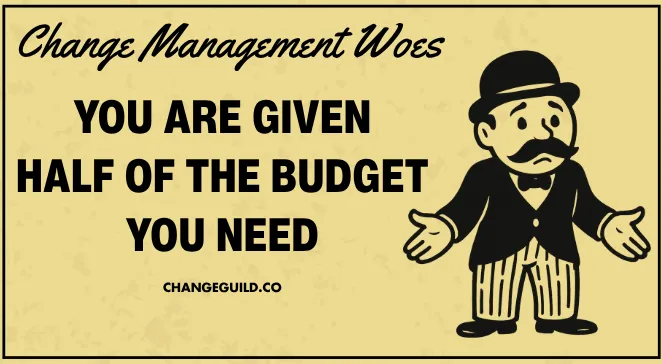Keeping leadership engaged when they’re stretched thin.
TL;DR: Busy sponsors aren’t the enemy, they’re the norm. The key isn’t to get more of their time but to make the time you do get count. Redefine engagement through sharp, high-impact actions (Signal, Shield, Sponsor), script “micro-moments” that amplify visibility, and act as their amplifier, not their scheduler. Smart leverage beats constant access every time.
The Paradox of Sponsorship
Every change practitioner eventually runs into the same paradox: the leaders who matter most are also the leaders with the least time to give. They’re juggling strategic decisions, external pressures, and day-to-day firefighting. They care deeply about outcomes, but their attention is the rarest commodity in the enterprise.
Sponsorship is consistently cited as the number-one success factor for change. Yet “too busy” sponsors often become the quietest risk, unintentionally starving projects of credibility and momentum. The irony is that the same leaders whose signatures open budgets are sometimes the very ones whose silence closes hearts and minds.
Practitioners must accept that “too busy” isn’t an excuse, it’s a condition of modern leadership. The challenge is to work with it, not against it. The goal isn’t to win more hours; it’s to earn sharper focus in fewer moments.
The Myth of Availability
It’s tempting to equate sponsorship with constant visibility. If a sponsor isn’t attending every meeting, reviewing every comms draft, or recording every video message, we assume we’ve lost them. That’s a myth. The goal is not unlimited access, it’s focused influence at the right moments.
A sponsor’s time is scarce currency; spend it where it buys the most impact. A single message delivered at the right altitude—a short note to peers reinforcing priorities—can do more than weeks of passive meeting attendance. One sponsor I worked with appeared at only two project events all year, but each time she spoke, she tied the change directly to business performance. Those moments echoed across the organization.
Contrast that with another leader who dutifully attended every steering meeting but rarely spoke. Their presence checked a box; their silence erased momentum. What employees see is not how often a sponsor shows up, but how decisively they do when it matters.
Redefine Engagement
Instead of asking for broad involvement, define engagement in sharp, specific ways.
Ask three questions when you design the sponsor’s role:
Signal: What visible actions only they can take?
- Record a 2-minute video reinforcing purpose.
- Reference the project in a quarterly update.
- Personally thank a team that hit a milestone.
Shield: Where must they provide cover against competing priorities?
- Intervene when a peer diverts key resources.
- Clarify that this initiative outranks other discretionary projects.
- Reinforce that metrics for success will be tracked.
Sponsor: Who do they need to bring along that you can’t reach yourself?
- Peers in the C-suite.
- Influencers in operations or finance.
- External stakeholders, boards, or regulators.
When you make asks this concrete, even a “too busy” sponsor can deliver. The art is in precision. If your request takes more than fifteen minutes to execute or explain, it’s probably not a good sponsorship ask. The best sponsors aren’t omnipresent, they’re surgically effective.
Don’t Confuse Activity with Impact
A sponsor who attends your weekly status meeting but says nothing is not engaged. A sponsor who spends five minutes calling a peer to clear roadblocks is. Measure impact, not presence.
Track sponsorship outcomes the same way you would measure campaign performance:
- Did the sponsor’s message reach the intended audience?
- Did it change behavior, unlock decisions, or unblock resources?
- Did people cite the sponsor’s leadership as a reason they believe the change will stick?
Practitioners often underestimate how far a small, well-placed action can ripple when it comes from the top. Influence has a half-life, it decays unless replenished by visible signals. Your job is to help sponsors fire those signals at intervals that sustain belief. Think of it as attention compounding: a single endorsement earns trust; repeated micro-endorsements cement it.
Create a Sponsor Playbook
“Too busy” sponsors benefit from a playbook that makes engagement effortless. Give them a menu, not a mystery.
| Frequency | Action | Why It Matters |
|---|---|---|
| Once a Month | Record a 90-second video or quote for internal channels | Keeps visibility consistent and humanizes leadership |
| Once a Quarter | Host a short Q&A or fireside chat with employees | Builds credibility and allows unfiltered feedback |
| As Needed | Intervene when resistance escalates beyond your reach | Reinforces authority and clears systemic blockers |
Present it as a service, not a demand: “We’ve mapped out a few high-leverage moments where your involvement will have the most impact. Which of these would feel authentic to you?”
Behavioral science tells us that people act more when friction is low and choice is bounded. A sponsor playbook reduces decision fatigue and reframes engagement as something that fits inside their existing rhythm rather than competes with it.
Use this tool early, ideally during project kickoff. Sponsorship onboarding should include a short conversation about expectations, preferred channels, and comfort zones. Some sponsors love video; others prefer town halls or emails. The key is to shape the method to the messenger.
Build in “Micro-Moments”
Sponsors don’t need hour-long workshops to demonstrate support. They need micro-moments—small, authentic gestures that reinforce the story of change.
Examples:
- A quick mention in an earnings call that ties results to the transformation effort.
- A short walk-through on the project floor, captured in a candid photo.
- A 30-second reference to the initiative in a weekly leadership huddle.
Micro-moments work because they travel socially. Employees notice unscripted authenticity more than staged appearances. When a leader casually references the project as part of everyday business, it signals that change is no longer a side project, it’s part of the fabric.
Practitioners should script and serve up these moments, not wait for sponsors to invent them. Prepare a “moment bank”: a running list of low-effort, high-visibility actions sponsors can take. Think of yourself as a producer setting the stage, lighting, and timing—then letting the sponsor step in for the spotlight cue.
Protect Their Time But Amplify Their Voice
One of the fastest ways to lose a sponsor is to waste their time. If you’re in their calendar, come prepared. Bring a crisp briefing, a clear decision request, and tools that make execution easy.
Before the meeting:
- Send a one-page brief with key decisions and talking points.
- Pre-draft the communication you’d like them to deliver.
- Include metrics or visuals they can reuse elsewhere.
During the meeting:
- Ask for one decision or one action.
- Frame everything in terms of business impact.
- End by confirming what you will amplify afterward.
Then, cascade whatever signal they send. If they record a 90-second video, clip it for social, internal sites, and newsletters. If they make a statement in an internal meeting, quote it in your decks and town halls. Sponsors don’t have to be everywhere, the message just has to sound unmistakably like them wherever it travels.
When you act as their amplifier, you protect their time while multiplying their reach. And when sponsors see their message echo through channels they never touch, they start to trust that their investment of minutes delivers the impact of hours.
Working with the Reality of “Too Busy”
It’s easy to resent the absent sponsor. But often, “too busy” is not disinterest, it’s triage. The modern executive lives in a swirl of meetings, investor calls, and crises. What you experience as neglect may simply be bandwidth collapse.
Your empathy is strategic capital. When you acknowledge the pressure they’re under and design engagement to respect it, you become a trusted advisor instead of another demand. Ask what their non-negotiables are this quarter, and shape sponsorship moments around them. The change effort will move faster when it feels additive, not competitive.
Final Thought
“Too busy” is real, but it’s also relative. The role of the practitioner is not to compete with every other demand on a sponsor’s time. It’s to distill engagement into the smallest, sharpest interventions that only they can make, and then ensure those interventions echo loudly.
Sponsorship today isn’t about heroic availability, it’s about intentional leverage. When leaders are stretched thin, the best change practitioners don’t chase access; they design for impact.
The most effective sponsor isn’t the one who shows up the most, it’s the one whose presence still shapes the room after they’ve left it.
ChangeGuild: Power to the Practitioner™
Frequently Asked Questions
What’s the biggest mistake practitioners make with busy sponsors?
They equate presence with engagement. A sponsor who shows up to every meeting but never advocates for the change isn’t truly sponsoring—it’s participation without influence.
How can I tell if a sponsor is genuinely engaged?
Look for visible advocacy and ripple effects. Are they reinforcing messages in their own forums, backing priorities when challenged, or clearing obstacles behind the scenes? Those are the real indicators of sponsorship.
What’s the best way to brief a “too busy” sponsor?
Keep it short, visual, and actionable. Provide a one-page brief that includes the decision, the rationale, and the impact. End with a suggested message they can reuse in their own words.
What if my sponsor keeps canceling meetings?
Assume it’s a bandwidth issue, not disinterest. Shift to asynchronous channels—record short video updates, use brief email summaries, and propose pre-scheduled “micro-moments” that fit their calendar.
How do I build credibility with a disengaged or distracted sponsor?
Respect their constraints. Deliver results, communicate clearly, and make it easy for them to look good when they act. When you prove you protect their time, you’ll often earn more of it.
How can I help sponsors make an impact without adding more meetings?
Design visible gestures that fit their workflow: a quick mention in a leadership call, a short recorded message, or a written note of thanks to a project team. These micro-moments travel farther than long meetings ever will.
When is it time to escalate sponsor inaction?
If project momentum stalls because of missing advocacy—key decisions delayed, messaging inconsistent, or blockers unaddressed—it’s time to raise the issue through governance channels. Frame it as a risk to outcomes, not a personal failure.








